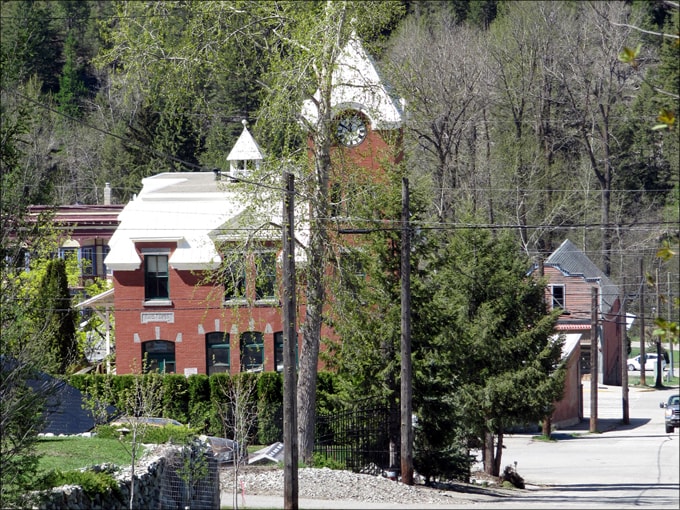Greenwood, British Columbia
BY: BG EDITOR

Greenwood Post Office
July, 2016 — GREENWOOD, BC (BG)
Officially Canada's 'smallest city', Greenwood, British Columbia is rich in history and community culture. Surrounded by natural beauty in the Boundary Region's Monashee mountains, Greenwood's historic main street - the heart of the community - is situated on Highway 3 between the Okanagan and Kootenays in the Southern Interior.
Known as one of southern BC's historic gems, the city of Greenwood continues to be a story in the making. Canada's smallest city has lived through many phases, from boom to bust: as a thriving mining town and a near ghost town; as a WWII Japanese internment center; and more recently as a period setting for a Hollywood movie. Greenwood endures, and like any good vintage it improves with age.
The history book opens in 1891, when prospectors discovered the rich lodes of copper-gold ore buried in the hills. By 1895, founder Robert Wood had purchased and settled the land that was to become Greenwood. Within the year a general store, three hotels, an opera house, livery, mining brokerage and two assay houses were opened to serve the growing settlement. The city was incorporated in 1897 and by 1899, the population had grown to 3,000.
'The B.C. Copper Company smelter began operation in 1901, servicing ore from the Mother Lode Mine and other mines in the area (including Nelson and Rossland). The smelter's 121 ft. brick smokestack was, according to the Vancouver Province, "one of the most complete and modern in the world today".
Greenwood became the supply center for surrounding mining camps and the city became the seat of government for the Boundary. With one hundred firms in the business district, the Board of Trade became their active representative. The community was served by the Times newspaper, and in 1906 by another, the Greenwood Ledge.

By 1910, however, the boom had passed and Greenwood's population was down to 1,500. By the end of WWI the demand for copper had dropped, and by 1918 the copper market was dead. The smelter in Greenwood lay idle, and the following year it was closed down permanently. The collapse of the smelter led to the closing of mines in the vicinity, and Greenwood itself began a long period of decline.' [1]
While Greenwood's population plummeted from its height of 3,000 to only about 200 inhabitants, that all changed with the advent of World War II. Greenwood's abundance of empty buildings made it the first of what would be several British Columbia internment camps for Canada's Japanese citizens. In 1942, well over a thousand Japanese were uprooted from their lives and put on trains destined for Greenwood, where they were made to reside in vacant houses and other buildings. They were among some 22,000 persons of Japanese descent who were displaced at the start of the war -- the largest mass movement of people in the history of Canada. But thanks to their presence, Greenwood was spared the fate of becoming a ghost town, like so many other small mining communities in the province.

Today, Greenwood's population of approximately 700 residents live in a jewel-like town filled with Victorian era homes, commercial and public buildings. Provincial Highway 3 (the Crowsnest Highway) drives straight through the heart of town on Copper Street, the main business corridor. In a town with no red lights, traffic flows through from Vancouver and Calgary, and all parts of the southern Boundary region that lies between them. Travelers are enticed to stop and eat, refuel, shop and visit in Greenwood's beautiful historic downtown.
Greenwood's economy is built on tourism, small business, forestry, agriculture and mining. Keeping its title as Canada's smallest city by population, Greenwood continues to be one of Canada's smallest cities geographically, at just 2.52 kilometers. (This official title goes to Duncan, which is 2.05 km.)
Greenwood's notoriety as an historic tourist destination grew significantly when it was chosen in 1997 as a location site for the filming of Universal Studio's movie, Snow Falling on Cedars. This Oscar-nominated movie, based on the book by David Gutersen, tells the story of a murder trial, surcharged with emotional turmoil following WWII and the Japanese internment. Greenwood City Hall's gorgeous Victorian-era courtroom was featured in a main scene from the movie, directed by Scott Hicks and starring Ethan Hawke, Max Von Sydow and Youki Kudoh.
Thanks to the movie, the facades of several Greenwood heritage buildings were given a much-needed refurbishment by the production company. A number of local Japanese-Canadian citizens — some of whom were actually interned here during the war — appeared as extras in the film. Photographs of the locally filmed scenes can be found at the Greenwood Museum.
REFERENCES:
[1] N.L. Barlee (1973), Gold Creeks and Ghost Towns. Canada West Publications / Wiki.








